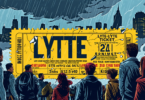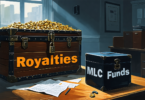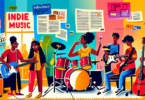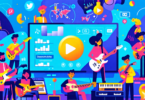YouTube has always been important to the music business. Now, with YouTube Music, it’s trying to build a music universe Spotify and Apple can’t touch.
For the last eight months, musicians and bands haven’t been able to tour, play festivals or go much of anywhere. So, trapped in their homes, they’ve improvised. Live concerts on Instagram. Epic shows in Fortnite and on Roblox. Nightly singalongs on Twitch. It’s not quite live, but it’s a thoroughly modern take on the music business.
When 6lack (pronounced “black”) and his team started thinking about their own live show, they wanted to do something out of the ordinary. “You’ve got your people who would just pull up a guitar and just turn on it live,” said Junia Abaidoo, a co-founder at LVRN records, 6lack’s label. “Or people who would go set up what looks like a real show, at a venue, but just stream it.
And you’ve got everything in between. And so it was really important to us to try to approach it in a way that was different and creative.” They eventually came up with an idea they loved: an artist performing from a live billboard, with the audience driving in and watching from their cars. It would be half live, half livestream.
Not that long ago, YouTube was at best a frenemy to the music industry. It would gleefully announce the billions it was paying in royalties, only for industry bodies to call it the single biggest threat to the music industry. Labels and artists didn’t think YouTube paid them enough, or cared enough about tracking down copyright violations. Even now, labels are hoping things like Article 17 in Europe will help force YouTube to pay more attention to its platform. But after years of careful effort and attention — not to mention new royalties deals the labels like a lot better — YouTube seems to be mostly back in music’s good graces.
Lyor Cohen, the head of YouTube Music and a legend in the music industry after stints at Def Jam and Warner Music Group, gets a lot of credit for changing that relationship. After Cohen showed up and a new payout deal was done, “they made it very clear that … they understood that they needed the perception of their platform to change from the industry perspective,” said Tarek Al-Hamdouni, the SVP of digital marketing at RCA Records. “They’ve done an excellent job of executing that.” Cohen was careful to say that the work’s not done, but he believes “we’re on the way to having a healthier relationship with the music industry.”
With that relationship on the right track, YouTube has now set on a different path: to assert and extend its dominance in the space. YouTube doesn’t want to be the place users discover new songs, only to leave and pay $10 a month to stream them on Spotify. It wants to put the entire music business onto a single platform. It has spent the last couple years building and improving the YouTube Music service, developing its very own $10-a-month premium streaming app. Now it’s shutting down Google Play Music, ramping up promotion for YouTube Music and preparing to battle with the giants.
On one hand, YouTube’s about a decade late to the party. YouTube said Music has more than 30 million paid subscribers (up 60% since last year), but Spotify has 144 million. Apple Music has more than 60 million. And that’s not including Pandora, Deezer, Tidal and the countless other ways people already listen to music.
On the other hand, it’s YouTube. It has entrenched, undeniable advantages, an audience larger than all its competitors combined and practically infinite resources. “It is arguably a better fit for Gen Z and younger millennials than Spotify is, as YouTube as a whole plays a much bigger part of their overall digital lives,” said industry analyst Mark Mulligan. For the last several years, YouTube has squandered all of that, with one bad or bailed-on idea after another. But now, YouTube has a plan for how to win the music wars.
Press Play
One easy knock on music-streaming services is that they’re all the same. Their libraries may differ slightly at the margins, but they all have about the same 60 million or so songs in their catalog. And Mariah Carey’s “All I Want for Christmas is You” sounds pretty much the same anywhere you play it.
Except on YouTube. There you can watch the original version, but also the Carpool Karaoke version, a duet Carey did with Justin Bieber, the scene from “Love Actually” that features the song, and countless live performances, covers and remixes. Want to learn a dance to the song in time for this year’s holidays? Want to learn to play the song on the guitar or piano? Want to hear a smash-cut version of President Trump singing the song? Want to know how that song got to be so irritatingly ubiquitous? That’s all on the first page of the YouTube search results. YouTube has a corpus of unique music content that none of its rivals can touch.
In recent years, YouTube’s also built a number of products for musicians: livestreaming and premieres, certainly, but also community features that let artists engage directly with fans. Artists can sell tickets on YouTube, either to virtual concerts or (someday) real-world ones. Programs like Foundry and Artist on the Rise help musicians grow on the platform with YouTube’s advice and promotion.
Most importantly, the monolithic YouTube has learned to have a personal touch. “It’s been a huge focus for the last decade,” said Vivien Lewit, YouTube Music’s content partnerships director and a key partner to the music industry. “Not only to build the best products and deliver the best music experiences for consumers, but to partner with and collaborate with artists in the music industry.” Nearly everyone in the music industry I spoke to had a YouTube contact whose name they knew, who consistently answered their calls. “You try and find a phone number for YouTube!” McNichol said.
YouTube tries to be a useful platform for all artists, but it seems particularly powerful for a younger generation of artists, many of who were on YouTube long before they were ever in “the music industry.” One of those artists is Tate McRae, the 17-year-old singer and dancer who first built an audience with videos of her dance recitals. In 2017, she uploaded a video called “i wrote a song … one day // tate mcrae.” That video rocketed around the web, racking up 34 million views and catching the eye of Matt Feldman, a manager at Hard 8 Working Group who now represents McRae. But he wasn’t the first to find her. “She had a champion at YouTube early on,” Feldman said, “before us.”
In February 2020, McRae, Feldman and YouTube started talking officially about how to work together. She wasn’t the most popular, or fastest-growing, artist on YouTube, but “they’re kind of able to read the tea leaves and collaborate with us,” Al-Hamdouni said. The side spent months figuring out what they wanted to do before YouTube named McRae one of its Artists on the Rise for 2020. In normal times, that would mean tour partnerships, lots of live opportunities and promotion all over the platform. In 2020, it meant putting together a biographical video heavy with animation and production value, working together on creating content and growing McRae’s channel … and promotion all over the platform.Al-Hamdouni said the only thing he wishes YouTube offered was a button he could push to get 100 million views shoved at any video he wanted. He’s convinced YouTube could direct that kind of traffic if it wanted. But he knows it’s right not to. “YouTube’s protective, smartly, of their algorithms,” he said. “They’re not going to do anything to compromise that, and they’re not going to do anything to shove content on the user’s throat.” It wouldn’t work anyway, he said. People vote by showing up and watching, not by being forced to do so. And luckily, plenty of YouTube users keep showing up.
Shuffle Playback
It seems like a foregone conclusion that YouTube should have the most powerful music streaming service. And yet, that’s hardly been the case. The problem, in part, was that YouTube in particular and Google in general never seemed able to stick to a plan for very long. Years ago, YouTube launched Music Key, a service that allowed people to listen to music in the background on their phone, download videos and skip ads. That was right around the time Google launched Play Music All Access, a cross between old-school iTunes and Spotify. As if having two services wasn’t confusing enough, they were both included in one subscription price, and had absolutely nothing to do with each other. Many people who could have gotten both services for free wound up paying for Spotify or Apple Music instead.
That part only got worse over time. Even when YouTube Music launched in 2015, it was part of YouTube Red, a confusingly broad subscription play that also included a subscription to Play Music. And YouTube Music was somehow different from YouTube, even though all that music was still on YouTube. Even the URLs were a mess: music.youtube.com and youtube.com/music went to two different places that seemed to be — yet again — totally unaware of each other.
Part of the equation is now mercifully simpler. There is but one Google music streaming service going forward, and it is called YouTube Music. It’s free with ads or $10 a month without (or free with YouTube Premium, so it’s still a little confusing), and it offers the full list of what you might call “Spotify Features:” tens of millions of songs, curated playlists, offline playback, albums in order.

YouTube has recently been asking people to switch from Google Play Music to YouTube Music, because now there’s only one app for that.Photo: YouTube
Getting to this point has taken a while, said T. Jay Fowler, the director of product management for YouTube Music. He’s been at the company for more than five years and has spent many of them, as he described, “peeling the layers back.” The YouTube Music team had to build tools to help people import their library and history over from Google Play Music, which had a small but fiercely loyal set of users. Then they had to build all those Spotify Features, because you can’t get anywhere else without them. “I want to fully acknowledge that we did spend a lot of time over the last several years building features that our competitors had,” Fowler said. “Not because we felt like we had to do it for the sake of doing it, because there are some baseline functionalities that most users need.”
As of now, though, the team at YouTube Music feels like it’s ready: Its product is on even footing with what’s out there, and it’s as easy to find and play and share everybody’s favorite new Fleetwood Mac track as it is on Spotify or Apple Music.
I’m Feeling Lucky
Now that YouTube Music has the music part mostly nailed, it’s time to figure out the YouTube part — which turns out to be a whole lot harder than it looks. Think back to “All I Want For Christmas is You.” All those search results are well and good, except that most people, most of the time, want to listen to the Mariah Carey song as it was recorded and as it is played umpteen millions of times every year. If YouTube instead plays “SpongeBob sings ‘All I Want for Christmas is You’ by Mariah Carey,” that’s not YouTube mining its great library of unique content. That’s a streaming service screwing up, badly.
Doug Ford is the person responsible for making sure that doesn’t happen. When he joined YouTube as director of music and product programming after five years in a similar role at Spotify, he found himself answering an oddly deep question: What is music? It’s a common one at YouTube, and one Fowler and others have been asking for years.
Think about it like this: 3.8 billion people have watched the music video for Psy’s “Gangnam Style.” Most of those people are likely not big fans of Psy, or K-pop in general, but instead found themselves checking out the video because it was one of the great cultural phenomena of 2012. Should YouTube’s algorithms and curators consider it a beloved tune or a silly video nobody will ever think about again?
These kinds of questions are absolutely everywhere on YouTube. Do users want to listen to the studio version of a song or the canonical live performance? What about a cover? If someone searches for “All I Want for Christmas is You,” are they trying to start a radio station of holiday music or listen to a dozen versions of the same track? Ford and his team have worked to classify songs with a thorough set of metadata concerning tempo, genre, style, instruments and much more. But how do you account for the fact that “Baby Shark” is the most popular video on YouTube? Is it the greatest song ever written?
Ford believes strongly that the solution is something that tends to be anathema to companies like Google: humans. “Programming is a pretty strong word around here,” Ford said. That’s clearly the case, given YouTube’s complicated history of trying not to get particularly involved in the content on the platform. In spots, Ford’s team gets very involved, like with the new Released playlist that complies every week’s best new music (another Spotify Feature) and some of the other human- and algorithm-curated playlists on the platform. In most cases, though, Ford prefers a level of interaction somewhat less than “radio DJ” and somewhat more than “black-box algorithm.” You might call it the Transparent Algorithm system. “We’re not doing it manually,” Ford said, “we’re not gatekeeping, but we’re making sure that those parameters are set up correctly across a plethora of different contexts.”

Even though it’s an audio service, YouTube Music still goes big on music videos.Image: David Pierce
Everyone on the YouTube Music team calls the big app YouTube Main. And figuring out what belongs on YouTube Music and what stays on YouTube Main is the big question left for them to answer. “Intuitively, it may make sense to take everything that’s music and put it in the Music app,” Fowler said. “But then you start poking at that: Do you really want guitar tabs in the music app? Do you really want karaoke versions in the music app? It’s not always cut and dry.” YouTube, which is mostly a lean-forward, search-and-recommendations experience, can intermingle all these things mostly successfully. YouTube Music, where people mostly just want to press play and go about their lives, can’t. Fowler said he has some theories, and YouTube’s tried some things that work, including relying on the third-party curators and always-on radio stations that are already so successful on the platform. But he acknowledged that there’s a lot more to do.
Getting this right is more important than it may seem. YouTube Music’s success is YouTube’s success, and getting as many people as possible to pay $10 a month gives YouTube a crucial non-advertising revenue stream. “I’m sorry to use this cliche,” Cohen said, “but it’s better to board a plane that has two engines than one.” Music could also be a model for YouTube building other premium services in niches like gaming and even with the platform’s best-known creators. The YouTube TV team is going through exactly the same debate as Music, too, trying to mix live TV and the YouTube library in a way that makes sense.
And while YouTube tries to become like music services, other services are becoming more like YouTube: Spotify continues to invest in video, and Facebook just signed a big deal to become another official home for music videos online. YouTube still has big advantages, but time has eroded some of them. If there are better places to go, the music business will go there.
But there’s one thing YouTube still has going for it: Everyone’s already listening to music there. All YouTube Music has to do is keep helping billions of people discover new music and then keep them from leaving when they do.
Update: This story was updated to properly refer to YouTube’s Vivien Lewit.







